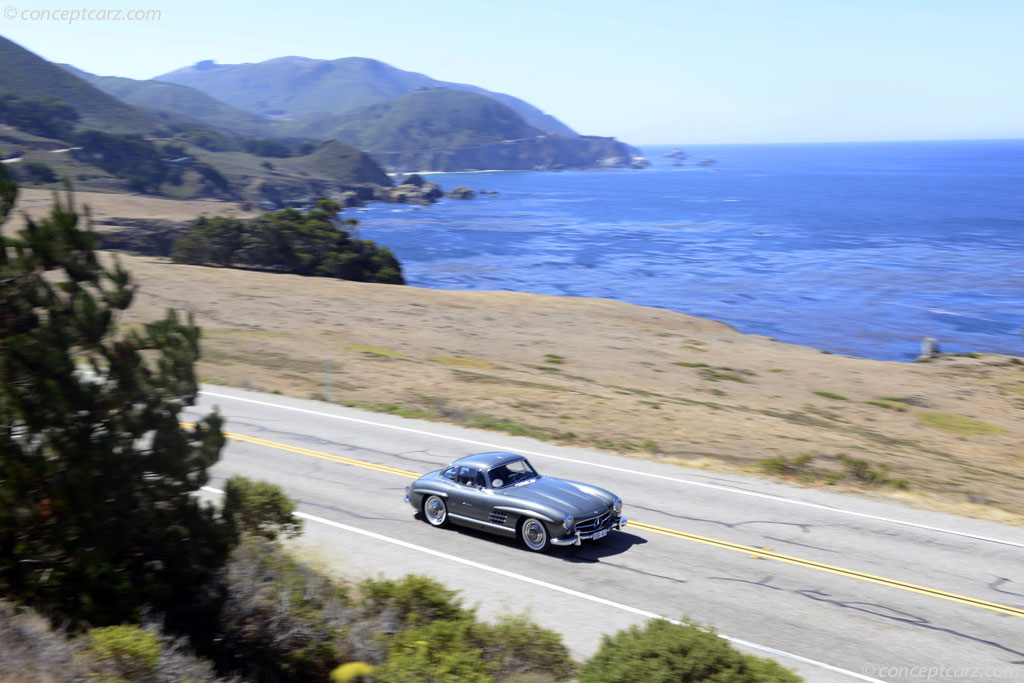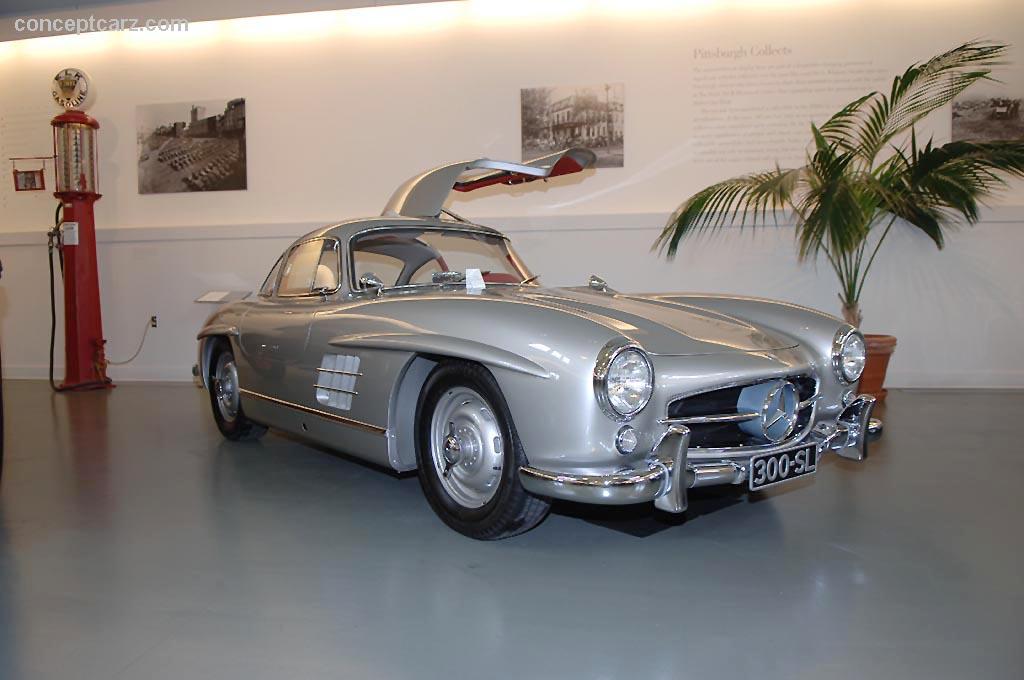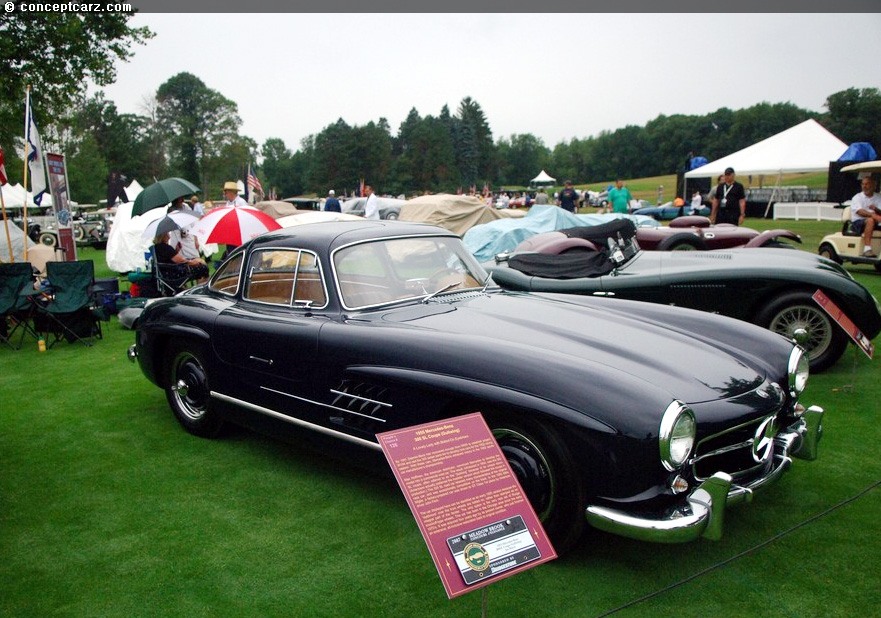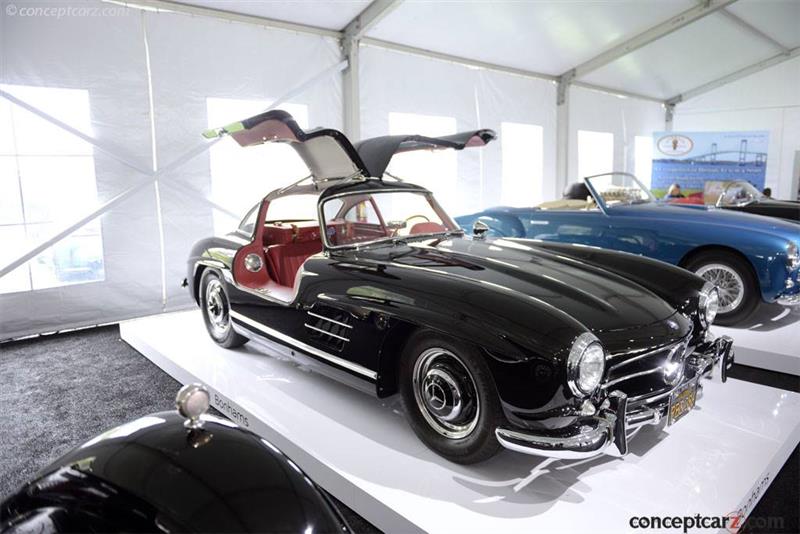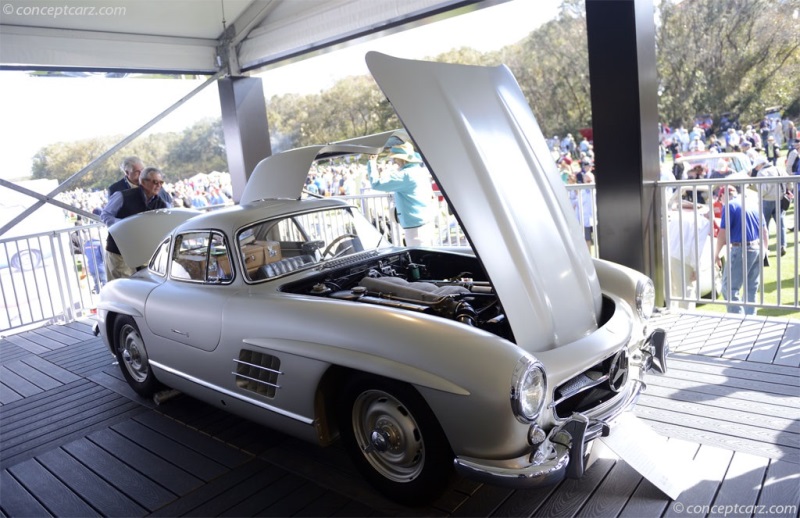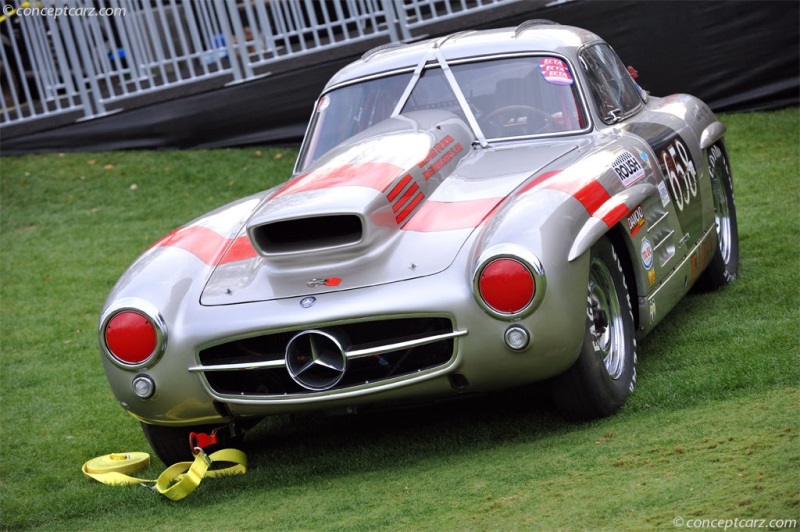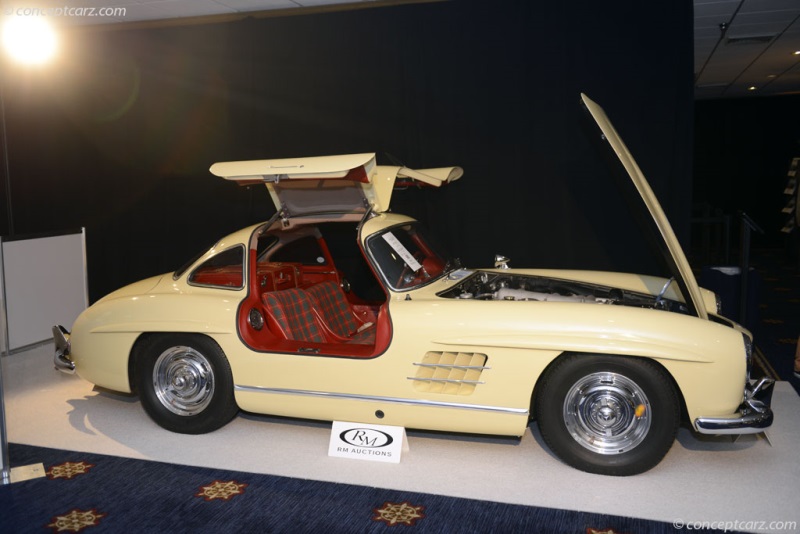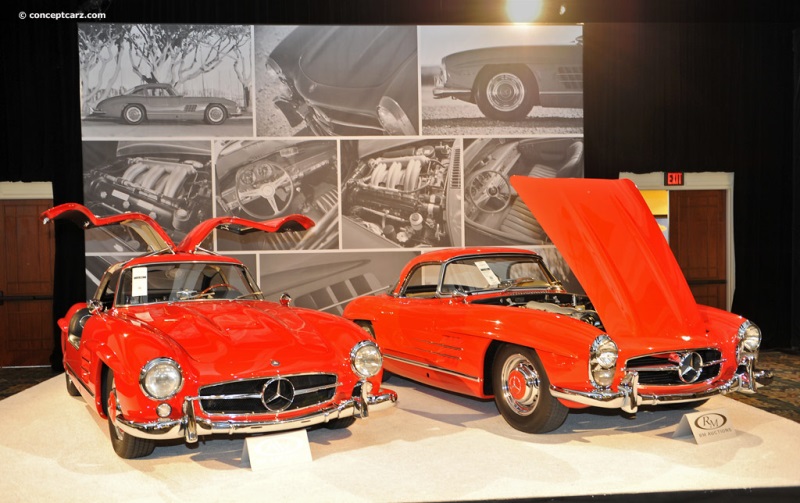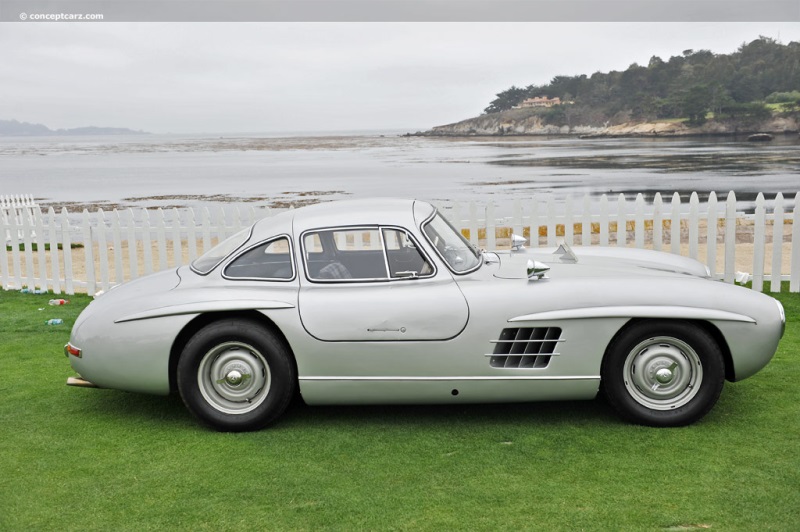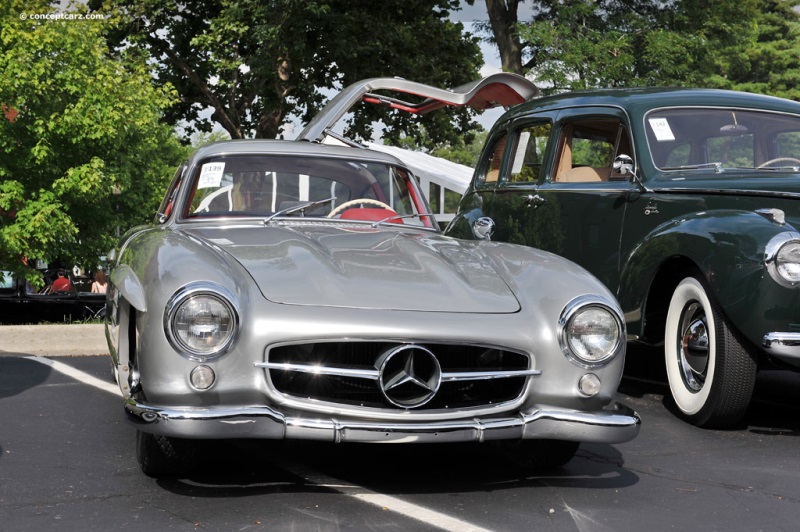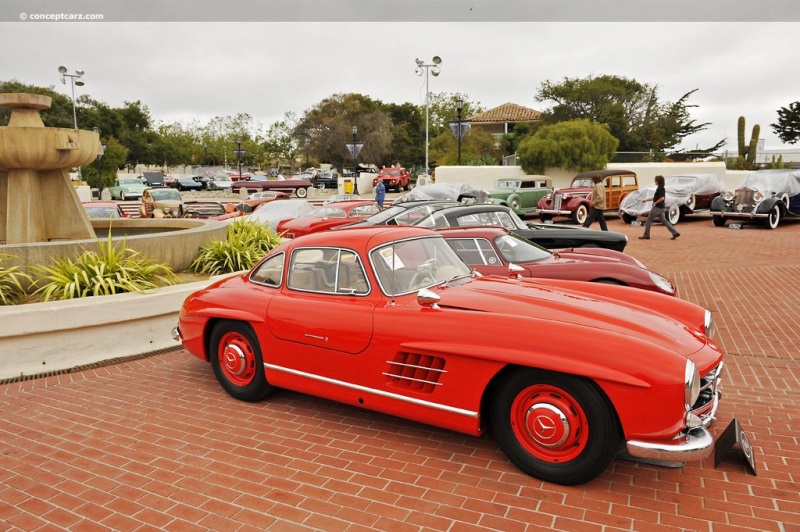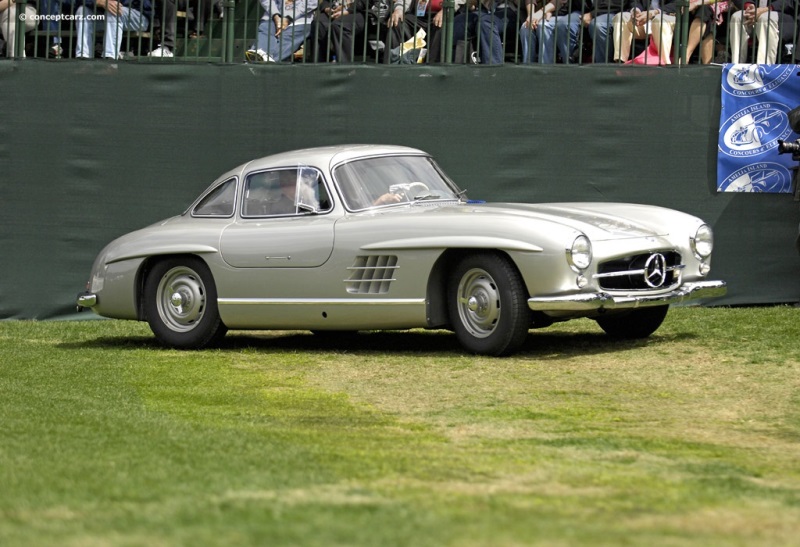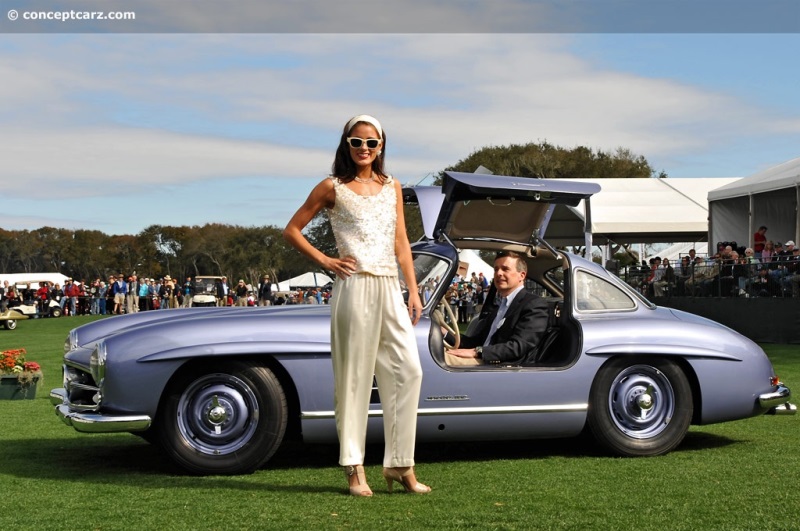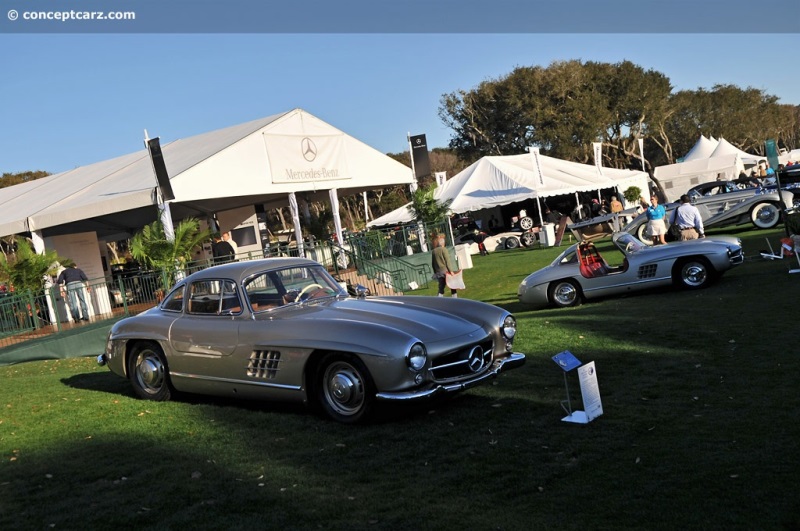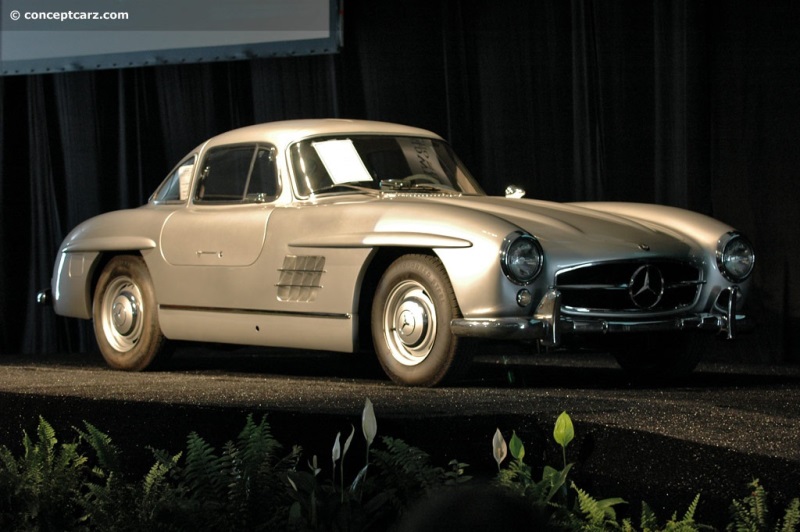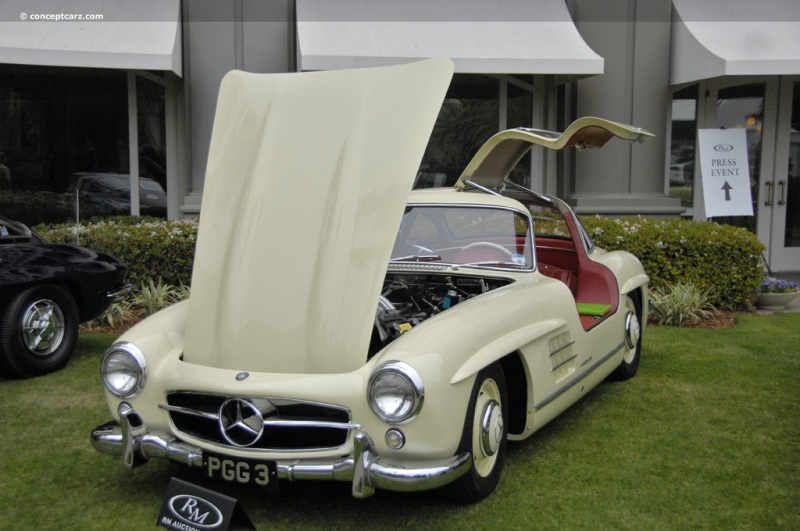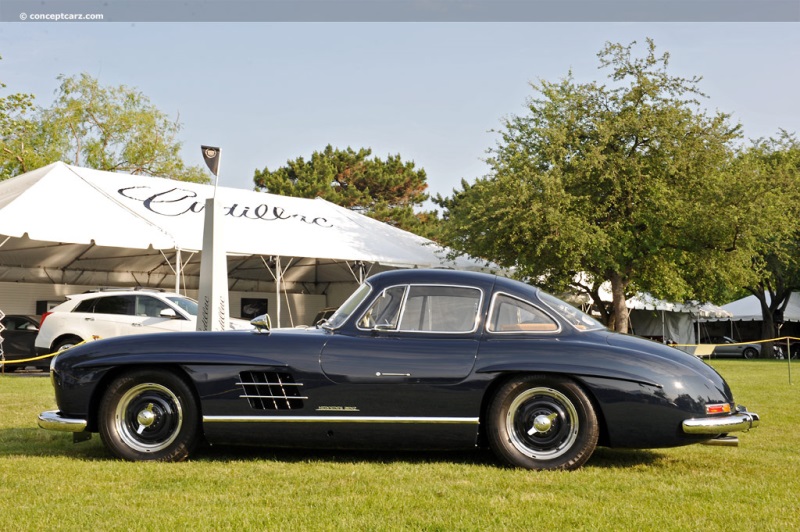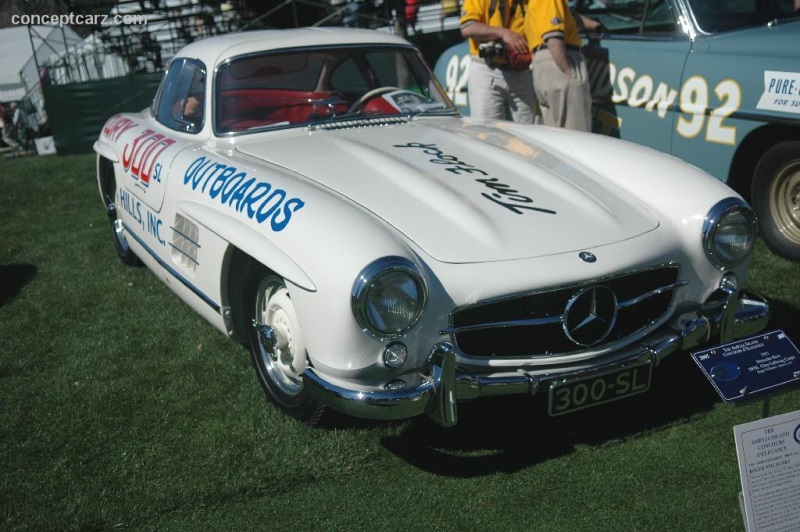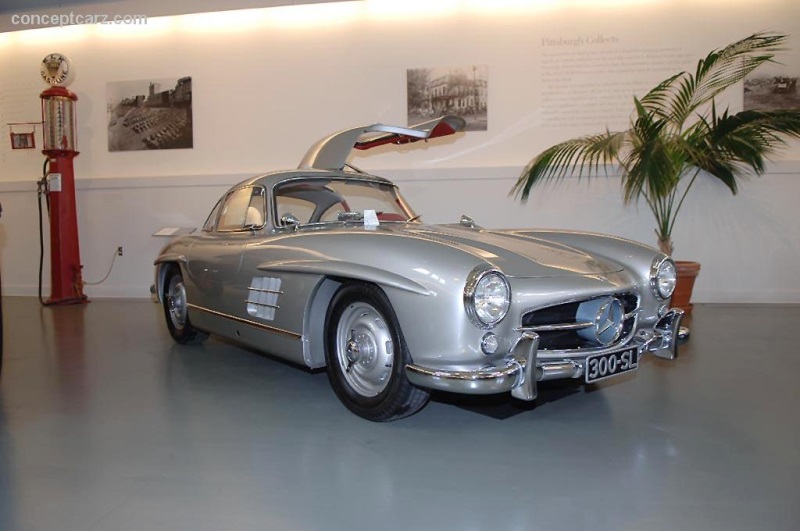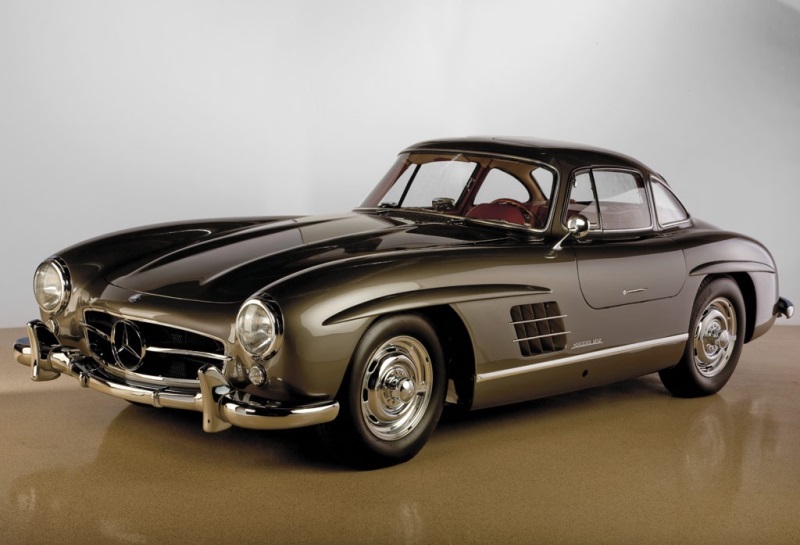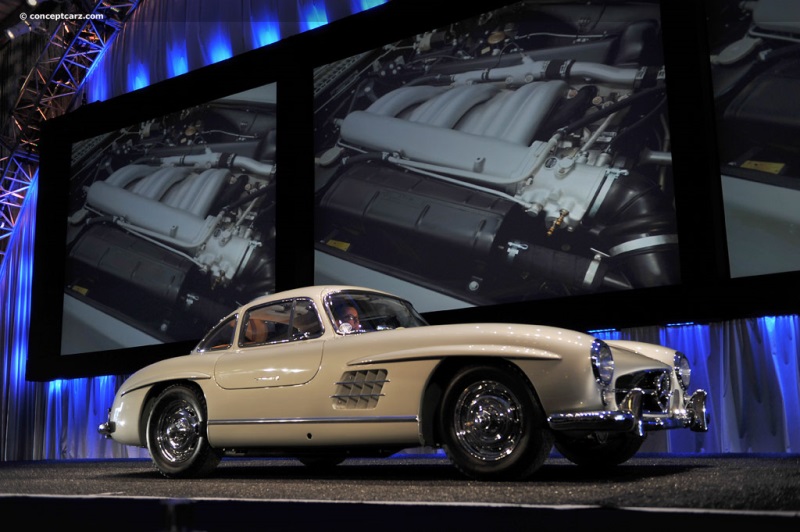The Mercedes-Benz 300SL was the direct descendant of the Mercedes Benz' Le Mans W194 competition coupe, conceived in 1952 and aimed at securing the World Sportscar Championship from Alfa Romeo, Ferrari, and Lancia. Its success was immediate and all-encompassing, including a first and second finish at the 24 Hours of LeMans. During the 1953 and 1954 seasons, the company concentrated on developing its new Grand Prix car. The SL reappeared in 1955, endowed with many of the advancements successfully tested on the company's Formula One racing cars. The year brought triumph and tragedy, with notable victories achieved prior to the devastating accident at LeMans where Pierre Levegh and more than 80 spectators died in one of racing's worst accidents, prompting Mercedes Benz to withdraw from racing for many years.
Coupe
Chassis #: 4500016
View info and historyTe New York importer Max Hoffman is credited with urging Mercedes Benz to build a production sports car based on the 300SL racing car. The appearance changed only slightly from the racing coupes and featured Bosch direct fuel injection. A total of 1,400 examples of the coupe were built from 1957 through 1957, and 1,858 of the roadsters from 1957 to 1963. The water-cooled 3.0-liter overhead cam straight-six engine delivered 240 horsepower at 6,100 RPM and 217 lb-ft of torque at 4,800 RPM. It had an independent suspension, a four-speed manual transmission, and four-wheel drum brakes. Pre-War OriginsThe legacy of Mercedes-Benz's racing program has achieved remarkable success over the years, not surprising as its two parent companies had already enjoyed independent success with their respective models, the Blitzen Benz and the Mercedes Simplex. Among the early accolades was a land speed record in 1909, and as such, Mercedes-Benz Motorsport traces its origins back to the late 19th century. 
CoupeBy the early 1920s, a newly designed supercharged was affixed to a six-liter engine and installed in a shortened wheelbase. This union resulted in what is considered the fastest touring car of its time, developing an impressive (for its era) 160 horsepower with the supercharger engaged. Between 1924 and 1929, Dr. Ferdinand Porsche was responsible for all engineering for Daimler, including the superchargers, and laid the foundation upon which the eight-cylinder cars would be built. The S Series followed, with further evolutions resulting in the SS and SSK models. The supercharged six-cylinder cars would establish the company's reputation internationally, and in its fully developed configuration, the supercharged 7.1-liter engine of the SSK could reach 300 horsepower, powering lightweight and streamlined coachwork to nearly 150 mph. The overwhelming performance was rewarded with many victories for Mercedes-Benz, including Rudolf Caracciola's wins at the 1931 Mille Miglia and German Grand Prix. A much-publicized rivalry was formed between the Rudolf Caracciola-piloted Mercedes-Benz Silver Arrows and the Ferdinand Porsche-designed Auto Union P-Wagens. The Silver Arrows remained unpainted, in an effort to save additional weight, and inadvertently determined the standard German racing colors for years to come. The countless records and victories established by the early Grand Prix cars solidified the company's reputation for engineering excellence and trendsetting construction.Postwar EndeavorsThe Mercedes-Benz facilities were virtually decimated during World War II, and when automobile production resumed in the post-WWII era, the focus was on civilian vehicles that would re-establish financial stability. Power was sourced from a new 3.0-liter (2996cc) overhead cam, aluminum head M186 straight-6 engine with twin downdraft Solex carburetors, and coupled to a four-speed all-synchromesh manual gearbox. Oversized intake and exhaust valves were due to an innovative diagonal head-to-block joint. It had deep water jackets, copper-lead bearings, a hardened crankshaft, and thermostatically controlled oil cooling. The engine was installed in a rigid X-shaped ovoid steel tube frame with a four-wheel independent suspension comprised of double wishbones, coil springs, and a stabilizer bar in the front. The rear used a traditional Mercedes' setup of double coil spring swing axle. A pedal-operated central lubrication system kept friction points silent, and hydraulic drums at all four corners provided the stopping power. The worm-and-sector steering was replaced in 1952 by recirculating ball.W194
Alloy Coupe
View info and historyWhen the company had rebounded, its facilities built, and financial prosperity returned, the company once again set its sights on competition. Daimler-Benz's chief developing engineer, Rudolf Uhlenhaut, designed a welded aluminum tube spaceframe chassis that weighed less than 150 pounds, yet retained high levels of rigidity and strength. The structure enveloped the passenger compartment making traditional doors impossible, resulting in the innovative and distinctive gull-wing arrangement. To save cost and time, the W194 used the overhead cam straight 6 M194 engine from the four-door 300 (W189) luxury tourer, with triple two-barrel Solex carburetors from the 300 S (188). The engine was canted at a fifty-degree angle to preserve a low hoodline. It developed 175 horsepower which was considerably higher than the 300s' 150 horsepower, yet underpowered when compared to much of the competition of the era. The company hoped its lightweight chassis, aerodynamics, precise steering, and four-wheel independent suspension would compensate for the engine's shortcomings. Devoid of door handles, trim, and bumpers, the low and sleek body had a drag coefficient of just 0.25. Mercedes-Benz fielded three examples for the 1952 Mille Miglia with one example, piloted by Karl Kling, finishing second behind a Ferrari. A few weeks later at a race in Bern, Switzerland, the W194 achieved its first victory. A one-two victory was achieved at Le Mans, a first for a closed-bodied car - and the first victory for Mercedes-Benz and Germany at LeMans. Four roadster versions raced at a minor race at the Nurburgring where they finished in the top four positions. At the Carrera PanAmericana in Mexico, the 300 SLs (W194) placced first and second. The 300 SL was not raced again by the factory following the end of the 1952 season. 
Coupe
Chassis #: 1980405500730It had taken Mercedes less than a decade after the end of World War II to re-established its place as a frontrunner in motorsport.300 SL W 198Daimler-Benz's official importer in the United States (a position he was appointed in 1952), New York Mercedes distributor Max Hoffman, saw an opportunity for a street version of the W194. While attending a meeting of Daimler-Benz's Board of Directors, he assured everyone in attendance of the salability of the current model lines, but also expressed interest in a production version of the 300 SL racing car. Initial hesitations to the idea focused on safety, as the development of the project was done quickly to meet Mercedes' re-entry into sports car racing. Hoffman prevailed and left Germany with an order for 1,000 SLs, half of which became the more affordable 190 variant. Over the months that followed, the car was treated to testing and refinement, resulting in a durable car that combined impressive performance with undeniable presence. It was introduced at the New York Auto Show in 1954 and the Coupe had a price tag well in excess of $7,000. The Roadster was $10,950 in the U.S.The 300 SL had a tubular frame atop a steel chassis, with a steel body attached to the frame. Aluminum was used for the dashboard, doors, bonnet, and boot lid. Twenty-nine examples were clothed with an all-aluminum body, which reduced weight by 176 pounds. The interior was offered with three checkered pattern seat fabrics or leather upholstery. The leather was standard on Roadsters. The cloth patterns included grey/green, grey/blue, and cream/red. The windows in the Roadster could roll down but were fixed in the Coupe.
Coupe
Chassis #: 1980405500229
Engine #: 1989805500246To accommodate easier entry and exit into the cockpit, the steering wheel pivoted on its hub 90 degrees away from the dashboard. Storage space was minimal, with a spare tire and fuel tank occupying the trunk (boot). Luggage could be stowed behind in the seats in the Coupe. The Roadster could be optioned with two custom-fitted leather suitcases for the larger trunk.M198 Engine and Mechanical Compoents
The water-cooled, 3.0-liter engine produced 240 (SAE) horsepower and 215 (DIN) horsepower. The Bosch mechanical direct fuel injection system was derived from the DB 601 V12 used on the Messerschmitt Bf 109E fighter of World War II. A race-bred dry-sump lubrication system reduced engine height by eliminating a traditional oil pan, and ensured proper oil distribution at high-speed cornering. The engine was tilted 50-degrees to the left to aid in the car's low profile persona. The engine was backed by a four-speed transmission with a single-disc dry clutch. Several rear axle ratios were offered, and with the lowest final gear ratio of 1:3.25, it had a top speed of 163 mph, making the 300 SL the fastest production car of its time. The 1:3.64 allowed a top speed of 146 mph and zero-to-sixty mph in 9.3 seconds. Faster acceleration was provided with ratios of 1:3.89 and 1:4.11. The stock rear axle ratio at the start of construction was 1:3.42, changing to 1:3.64 after the 40th vehicle.The wheels on the Coupe were smaller than the roadster and were steel bowl/aluminum rim rivet compound wheels. The Rudge 5J x 15-inch rims were optional. The coupe wore 6.50-15 inch tires while the roadsters measured 6.70-15.The self-cooled, turbo drum brakes from the 300S were used for stopping power, and a brake booster was used to reduce the pedal force. The brake shoes were 4-inches wide, the front drums were two-wheel brake cylinders/wheel, and the rear drums were one-wheel brake cylinder/wheel. The Roadsters used the same drum brakes until March of 1961 when 11.4-inch disc brakes were added at all four corners.300 SL Roadster
The 300SL Roadster was first exhibited at the Geneva Salon in May 1957 and produced through 1963. It had conventional doors, a redesigned cockpit area, and weighed 276 pounds more (at 3,131 pounds) than the Coupe. In ConclusionIts racing parentage notwithstanding, the 300 SL remains a thoroughly practical car, as civilized in city traffic as it is potent on the track. The majority of 300 SL production was delivered new to the United States. It was the right car for the right time and the price almost didn't matter. They remain one of the most coveted of all sports cars ever built.
by Daniel Vaughan | Dec 2007
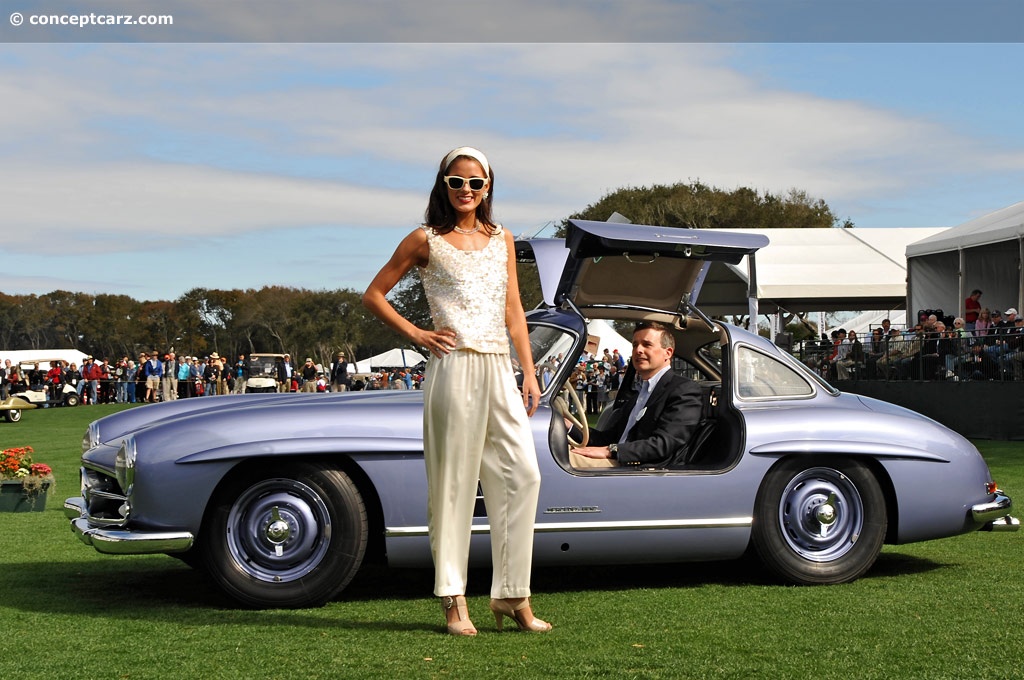
Coupe
Chassis #: 4500016
View info and history
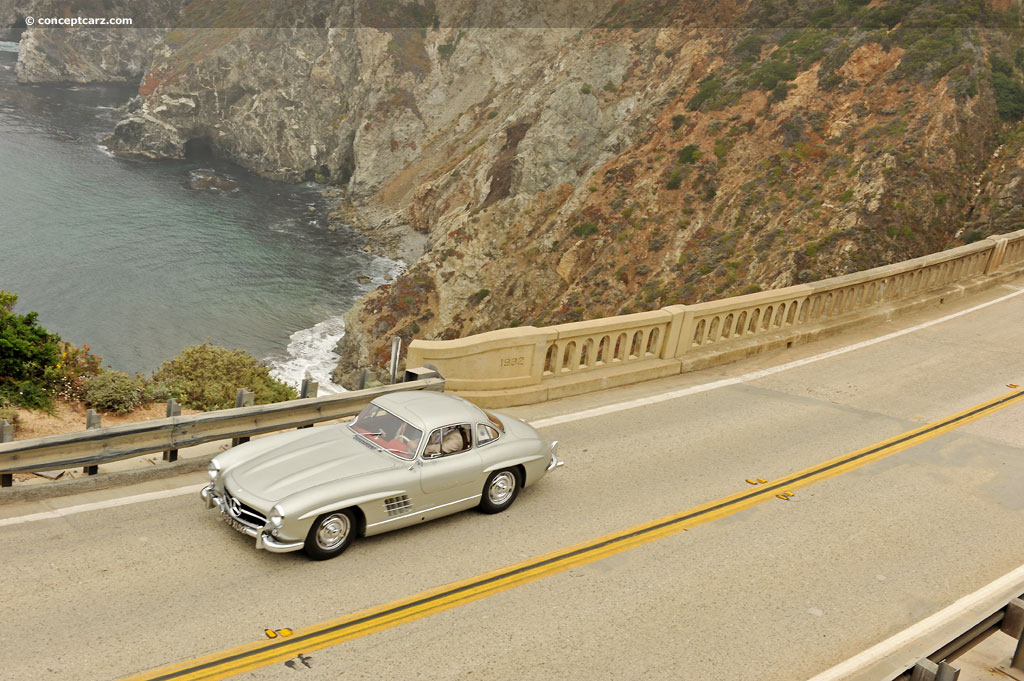
Coupe
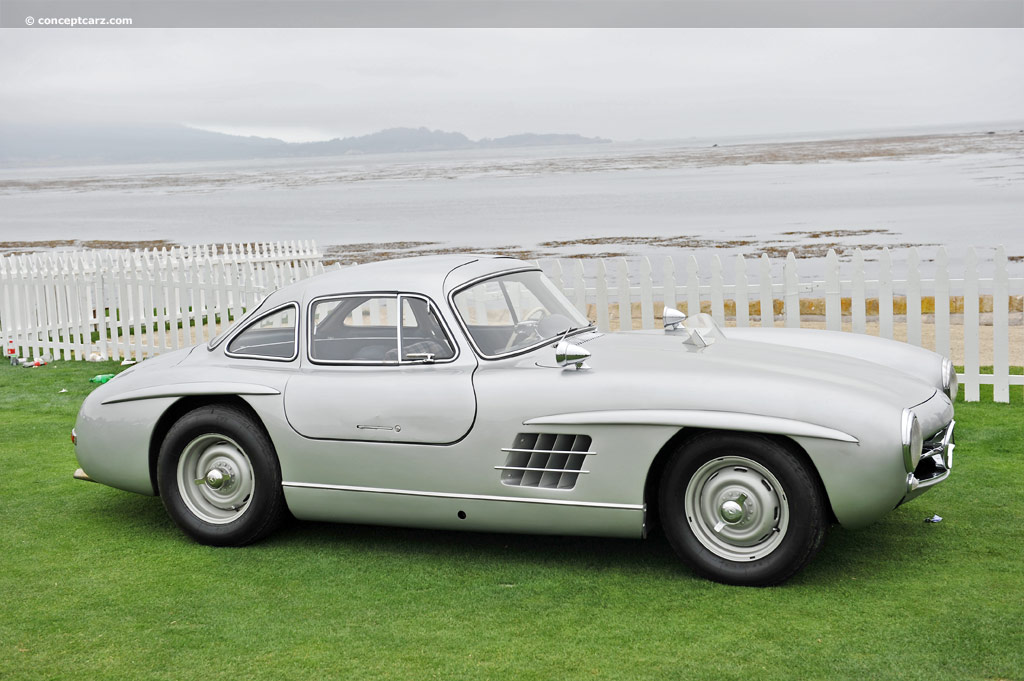
Alloy Coupe
View info and history
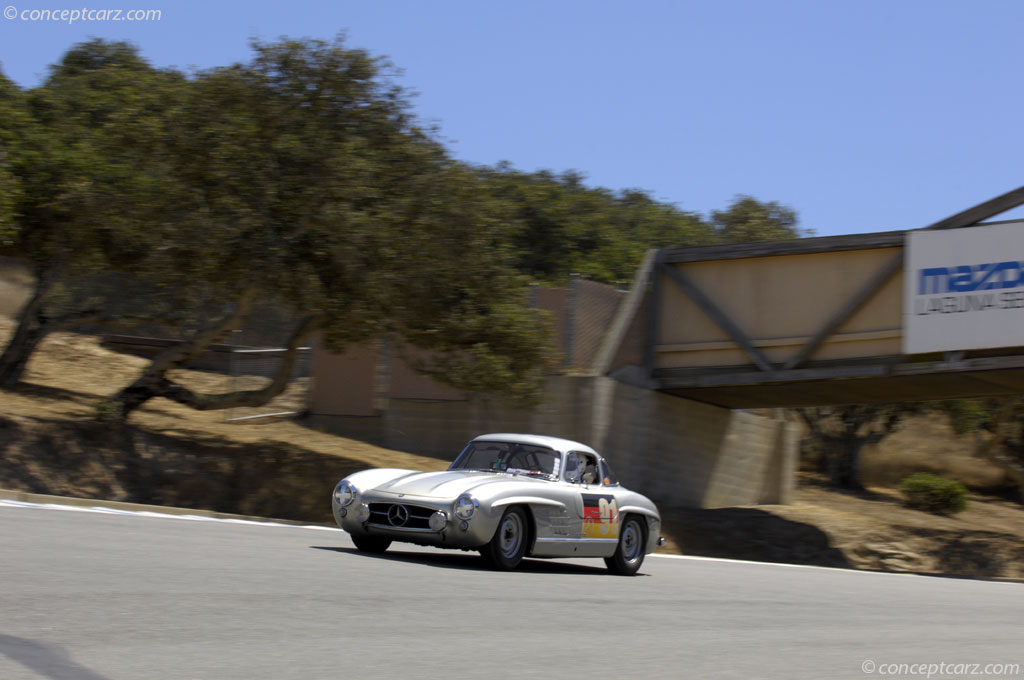
Coupe
Chassis #: 1980405500730
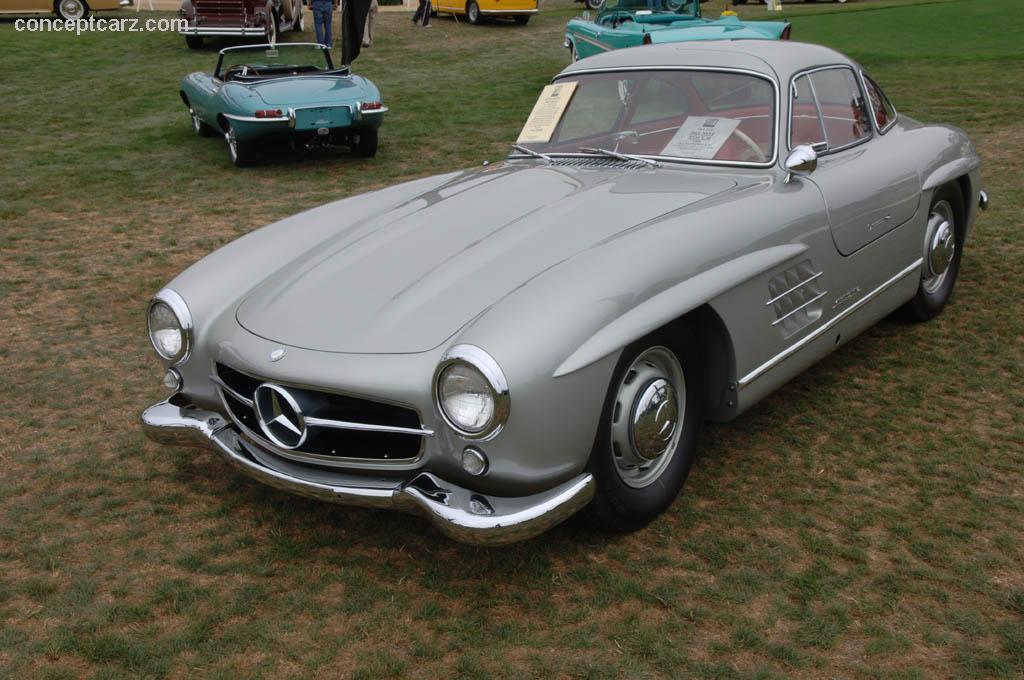
Coupe
Chassis #: 1980405500229
Engine #: 1989805500246
The water-cooled, 3.0-liter engine produced 240 (SAE) horsepower and 215 (DIN) horsepower. The Bosch mechanical direct fuel injection system was derived from the DB 601 V12 used on the Messerschmitt Bf 109E fighter of World War II. A race-bred dry-sump lubrication system reduced engine height by eliminating a traditional oil pan, and ensured proper oil distribution at high-speed cornering. The engine was tilted 50-degrees to the left to aid in the car's low profile persona. The engine was backed by a four-speed transmission with a single-disc dry clutch. Several rear axle ratios were offered, and with the lowest final gear ratio of 1:3.25, it had a top speed of 163 mph, making the 300 SL the fastest production car of its time. The 1:3.64 allowed a top speed of 146 mph and zero-to-sixty mph in 9.3 seconds. Faster acceleration was provided with ratios of 1:3.89 and 1:4.11. The stock rear axle ratio at the start of construction was 1:3.42, changing to 1:3.64 after the 40th vehicle.The wheels on the Coupe were smaller than the roadster and were steel bowl/aluminum rim rivet compound wheels. The Rudge 5J x 15-inch rims were optional. The coupe wore 6.50-15 inch tires while the roadsters measured 6.70-15.The self-cooled, turbo drum brakes from the 300S were used for stopping power, and a brake booster was used to reduce the pedal force. The brake shoes were 4-inches wide, the front drums were two-wheel brake cylinders/wheel, and the rear drums were one-wheel brake cylinder/wheel. The Roadsters used the same drum brakes until March of 1961 when 11.4-inch disc brakes were added at all four corners.300 SL Roadster
The 300SL Roadster was first exhibited at the Geneva Salon in May 1957 and produced through 1963. It had conventional doors, a redesigned cockpit area, and weighed 276 pounds more (at 3,131 pounds) than the Coupe. In ConclusionIts racing parentage notwithstanding, the 300 SL remains a thoroughly practical car, as civilized in city traffic as it is potent on the track. The majority of 300 SL production was delivered new to the United States. It was the right car for the right time and the price almost didn't matter. They remain one of the most coveted of all sports cars ever built.
by Daniel Vaughan | Dec 2007
Related Reading : Mercedes-Benz 300 History
With a top speed of 130-155 mph, depending on the axle ratio, the 300SL was one of the fastest vehicles of the 1950s. Its performance, design, reputation, and futuristic Gullwing doors were all responsible for the success of the vehicle. The SL represented Sport Leicht or Sport Light. An American Max Hoffman is partly responsible for the mass-production of the 300SL. He had urged Mercedes-Benz....
Continue Reading >>
Continue Reading >>
Related Reading : Mercedes-Benz 300 History
The Mercedes-Benz 300 was produced from 1951 through 1958 and is one of the most graceful and classic creations of the post-World War II era. The style was both classic and modern and built to high standards. They were constructed from fine materials using the latest in technology and achieving minimal weight with a high degree of strength. The 300 was built on a traditional body-on-frame construction....
Continue Reading >>
Continue Reading >>
Related Reading : Mercedes-Benz 300 History
Eternal youth is a miracle bestowed on only a small number of cars, and the Mercedes-Benz 300 SL coupe is one of this elite group. The Stuttgart-based brand unveiled its new sports car in February 1954 at the International Motor Sports Show in New York, and in so doing lit the fuse for an icon of the automotive world. With its flat, graceful body, the 300 SL had lost nothing of its freshness even....
Continue Reading >>
Continue Reading >>
Related Reading : Mercedes-Benz 300 History
Large and luxurious, the Mercedes 300 series was built from 1951 until 1957 in its original form. The companys largest and most-prestigious models, the Mercedes-Benz Type 300 is considered a trademark of the era throughout the 1950s. With a 3 liter engine capacity, the name 300 said it all. Exclusive, expensive, elegant and full of power, the Type 300 vehicles were in an elite status all of its own.....
Continue Reading >>
Continue Reading >>
Mercedes-Benz
Similar Vehicles
Similarly Sized Vehicles
from 1955
1955 Mercedes-Benz 300 SL Gullwing Vehicle Profiles
Vehicle information, history, and specifications from concept to production.
